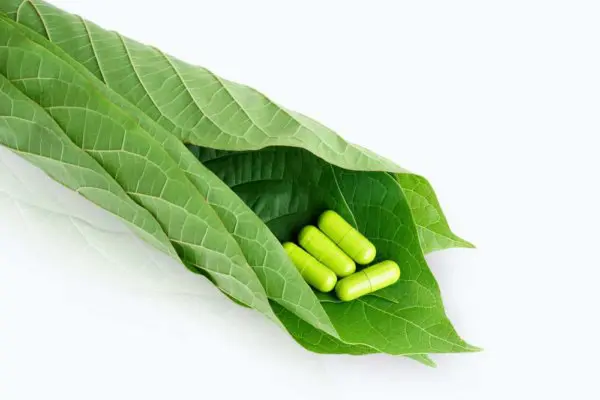What is Kratom?

Kratom is a plant originating from Southeast Asia with a long history of use in traditional medicine and herbal remedies. The plant, which has opium-like narcotic effects, is used as both a narcotic painkiller and a stimulant to increase energy, which most would consider natural considering the plant’s relation to another substance that many of us use, coffee. At low doses, the powdered or fresh leaves work as a stimulant, while at high doses, they act as a heavy narcotic sedative.
Like many other plants with narcotic effects, Kratom also has a mixed history. The plant is banned in its home countries of Thailand, Malaysia, and Myanmar, because of it’s addictive opioid-like effects. At the same time, the plant is rising in popularity in the United States, largely for use as an opioid withdrawal medication.
Users, especially those attempting to self-manage pain and withdrawal, use kratom to relieve withdrawal symptoms. However, this use is met with mixed results, and heavy criticism from professionals. Before using Kratom, you should consult with a doctor and take the time to consider the possible implications and side-effects of its use.
Users, especially those attempting to self-manage pain and withdrawal, use kratom to relieve withdrawal symptoms. However, this use is met with mixed results, and heavy criticism from professionals. Before using Kratom, you should consult with a doctor and take the time to consider the possible implications and side-effects of its use.
How Does Kratom Work?
Kratom is relatively new to the Western World, and as a result, it’s study has been limited. Researchers have identified over 40 active compounds in the leaves, the most active of which is mitragynine. Powdered leaf typically consists of 1.2-2.1% of this substance, with some dried products featuring as much as 7% mitragynine.

More importantly, mitragynine in its purest form is an alkaloid that affects opioid receptors in the brain similarly to morphine, but at 7 times the potency. Kratom also contains other active opioid receptor agonists, including the even more potent 7-hydroxymitragynine, which is present in very small doses. These ingredients are thought to act as agonists for the mu-opiate receptors, delta-opiate receptors, and kappa receptors. They also work as anti-inflammatory agents, analgesics (pain relievers), and interact with neurotransmitters to some extent.
This works to create stimulating effects at lower doses, which kick in within 10 minutes of taking the drug. Here, users can experience energy, alertness, decreased appetite, and lowered inhibitions. It can also cause anxiety, agitation, and other stimulant-like side-effects.
At higher doses, Kratom users experience a euphoric high, which is sometimes describes as pleasant and sometimes not. Here, users experience drowsiness, calm, and reduced pain. In very high doses, kratom can cause heavy sedation and a lack of consciousness.
Is Kratom Dangerous?
Kratom is currently not a controlled substance in the United States because of several factors. The first is that the drug is relatively new to the U.S market, and has only been available for a little over a decade. The second is that with very little research showing the effects of Kratom, the DEA has been unable to push a ban through. In 2016, a proposed 2-year ban on the substance was halted after protests.
The truth is that at this time, we don’t currently have enough information to trace the long-term effects of Kratom, simply because it hasn’t been on the market long enough. However, we do know that Kratom can be dangerous when combined with other drugs. Between 2014 and 2016, 15 deaths relating to a combination of Kratom and other substances.
In very high doses, Kratom may cause seizures through blood toxicity.
Known Side Effects of Kratom

Kratom produces several side-effects, which can range from mild to dangerous. Common side effects include constricted pupils, flushing in the face and extremities, constipation, sweating, dizziness, nausea, vomiting, itchiness, and in some cases, tremors. Over long-term use, high-dose users might begin to see extreme weight loss, symptoms of psychosis, and possible hyperpigmentation or facial darkening (as observed in users of Asian descent). Kratom does not appear to have the same effects on the liver and internal organs as opioids, and does not seem to cause the same level of damage. However, is has not yet been extensively studied in a full-usage trial.
Is Kratom Addictive?
While Kratom is most-often used in the United States for withdrawing from other substances it is, itself, addictive. Kratom affects the same opioid receptors as other types of drugs, and it displays many of the same addictive properties. For example, in Southeast Asia, users become progressively more tolerant, requiring larger doses to get the same high or effect. Some eventually compulsively use the drug, which eventually has a negative impact on the user’s life. In one study, nearly 95% of long-term users developed a dependency after 6 months, including withdrawal symptoms, cravings, and psychological withdrawal.
With withdrawal symptoms almost exactly matching those of opioid withdrawal symptoms, including sweating, fever, anxiety, panic, diarrhea, muscle tremors, insomnia, depression, mood swings, and irritability, Kratom is addictive according to all 8 factors used to identify dependence inducing drugs by the DEA. However, it is also recognized as less addictive and less dangerous than drugs like morphine. Users do not see it as a preference drug for recreational use and typically do not experience the same level of high as with amphetamines or other opioids. So, while Kratom is addictive, it is less so and less dangerous than most Schedule 1 drugs.
Using Kratom for Withdrawal

Kratom is most popular in the United States for its use as a withdrawal aid. The drug has a long history of such use, with the first documentation of its use as an opioid alternative dating back to the 17th century in Thailand and Malaysia. Kratom also has well-documented effects that alleviate withdrawal symptoms, including acting as both a sedative and a pain reliever. By stimulating the same opioid receptors, Kratom can also effectively block withdrawal symptoms altogether by preventing the active source of withdrawal. So, Kratom can be used to alleviate withdrawal symptoms, similarly to many medically approved withdrawal drugs such as Buprenorphine. Studies show that persons who follow through on courses of kratom can successfully withdraw from their original drug.

However, Kratom is addictive itself. Swapping one addictive drug out for another simply enables you to overcome the initial addiction. Once you’ve done that, you will still have to withdraw from Kratom, and experience the same withdrawal symptoms you were avoiding. Kratom is also more difficult to withdraw from, largely because there are very few medications that are useful in treating withdrawal symptoms.
Finally, while Kratom can help to alleviate the physical withdrawal symptoms of many drugs, it cannot help with psychological addiction. Many persons who are dependent on substances develop a mental reliance on drugs or alcohol, using them to cope with stress and emotions. Simply withdrawing from a substance does not help you to develop these coping mechanisms. As a result, Kratom is not a long-term solution for helping users to stay drug free. Instead, it’s a replacement drug, which is less dangerous but still addictive and still potentially damaging to your life and quality of life.
If you or a loved one is suffering from an addiction, Kratom is not a solution. Instead, you should seek out a rehab facility which can offer medical guidance for safe detox and withdrawal and therapy to help build up the skills and coping mechanisms necessary to live life without using substances to cope. A quality rehabilitation center will offer a great deal of support, including non-addictive prescription drugs such as buprenorphine to help with withdrawal symptoms, cognitive behavior therapy (or similar therapy) to build up coping skills, and other types of therapy.
If you or a loved one is suffering from a Kratom addiction, get help. Please contact Beginnings Treatment Centers to speak with one of our experienced and professional intake advisors, a quick action might save your life or the life of your loved one. We are located in beautiful and sunny Southern California in Orange County, which has one of the strongest and most active recovery communities in the United States. Contact us today!

